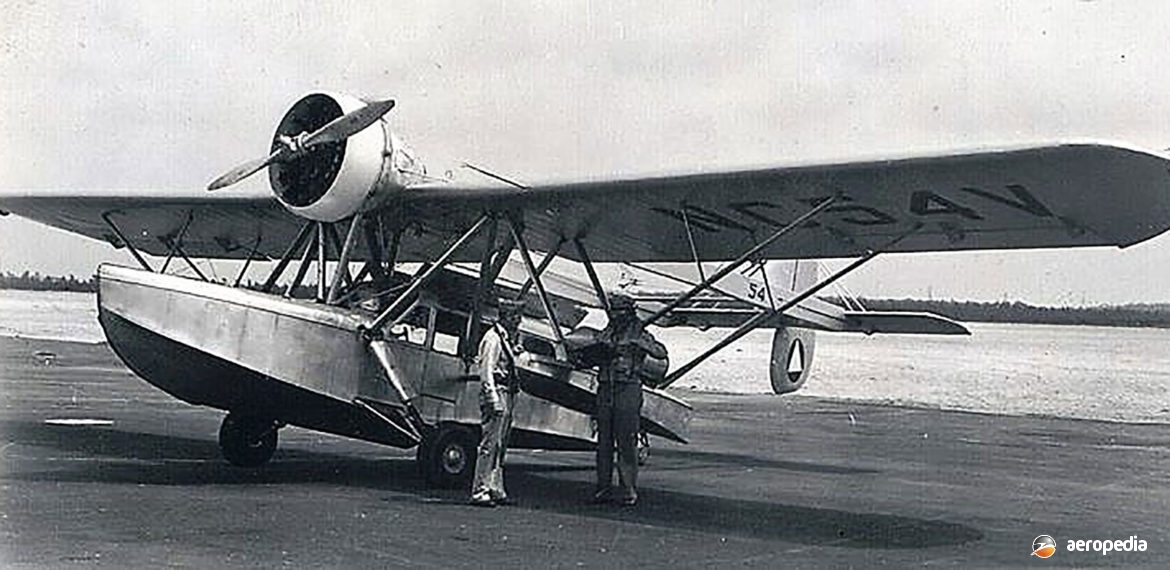Photograph:
Sikorsky S-39 NC54V (c/n 916) in the United States in about 1937 (Author’s collection)
Country of origin:
United States of America
Description:
Business and executive amphibian
Power Plant:
One 224 kw (300 hp) Pratt & Whitney Wasp Junior nine-cylinder air-cooled radial engine
Specifications:
- Wingspan: 15.84 m (52 ft)
- Length: 9.7 m (31 ft 11 in)
- Wing area: 32.51 m² (350 sq ft)
- Max speed: 185 km/h (115 mph)
- Cruising speed: 156 km/h (97 mph)
- Initial rate of climb: 244 m/min (800 ft/min)
- Ceiling: 5,486 m (18,000 ft)
- Empty weight: 1,159 kg (2,555 lb)
- Loaded weight: 1,678 kg (3,700 lb)
History:
Following the success of the S-38 series, Sikorsky designed the S-39 specifically aimed at the sportsman pilot, the first production S-39A being flown in the National Air Tour of the United States in 1930. A Director of United Aircraft, Col A G Deeds, had one installed on the deck of his yacht, the aircraft being lowered to and lifted from the water by means of a derrick. Seating four, the type became popular, being developed to the five-seat S-39B.
Designed by Igor Sikorsky, a Russian Emigre, it was a scaled down S-38 and initially had two 86 kw (115 hp) Cirrus Hermes engines, making its first flight on 24 December 1929 flown by Boris Sergievsky, but on its third flight it lost an engine and crashed. It was decided to re-design the aircraft into a single-engine machine with a 224 kw (300 hp) Pratt & Whitney Wasp. The second S-39 was flight tested in February 1930 and, after undergoing some design modifications, entered production as the S-39A. Twenty were constructed as ship sets. However, only a few were sold and the remainder were scrapped. In all ten S-39As were completed, one going to the Cunard Line in the United Kingdom as G-ABFN.
The S-39B was an improved model with seating for five and a larger baggage allowance. One was flown in Africa with the Martin Johnson expedition, flying 96,558 km (60,000 miles); one climbed to 5,682 m (18,641 ft) for a Class C.3 record; and another record was set by flying a 100 km (62.13 miles) closed circuit at 160.84 km/h (99.95 mph).
In December 1935 the Oroville Company was in the process of searching for gold in the Upper Sepik area of New Guinea. To assist in this endeavour the company obtained from the United States an S-39B amphibian (NC54V – c/n 916) fitted with a Pratt & Whitney Wasp Junior engine of 224 kw (300 hp). A permit was obtained to operate the aircraft in New Guinea and the machine, when it arrived, was assembled at Rose Bay in Sydney, NSW and flown to Port Moresby, PNG in September 1936. It was used to carry freight and passengers to a forward camp near Flint Island, 129 km (80 miles) up the Fly River; and later used to drop supplies to reconnaissance teams searching for gold. A landing ground was prepared at Telefomin and, on 26 October 1936, the S-39B was flown in, this strip being at an altitude of 1,524 m (5,000 ft) and being 366 m (1,200 ft) long. Many tonnes of stores and fuel were flown to bases, Telefomin becoming a base for exploration into unexplored territory. However, no gold was found in the areas explored.
In 1939 the aircraft was flown to Australia by Stuart Campbell and shipped to the United States for its new owner, H G Fales of New York. During its time in New Guinea the S-39B was only out of service for a short period when some damage was occasioned to an undercarriage leg.

